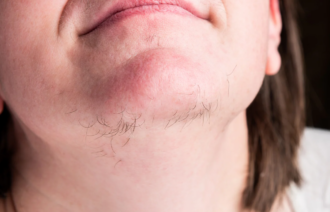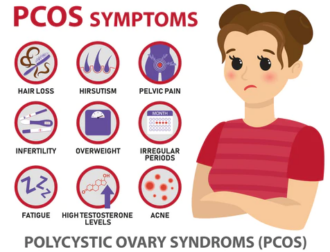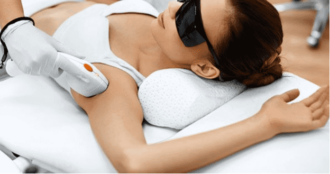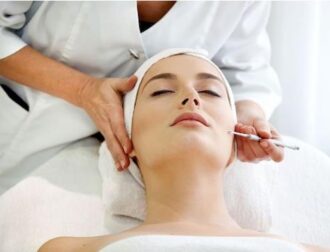Introduction
Alright, picture this: while getting dressed for that big event you have been preparing for for almost three months, you quickly glanced at the mirror and saw strands of hair growing on your sensation. You feel that familiar sensation, after all, you have only plucked out some strands off your face a couple of days back, and now the unwanted hair is back. Note this is not just your usual morning shave or brow touch-up. We are talking about the unwanted hair that grows on your face, and legs and makes you so not-confident in yourself.
Imagine waking up to catch a glimpse of yourself in the mirror. Instead of focusing on your charming bedhead, your eyes lock onto those persistent little hairs that just won’t quit. It’s like they have a mind of their own, right? Well, you’re not alone. Excessive hair growth is a common occurrence in the world all over.
Sadly, many have explored different ways to stop unwanted hair growth but to no avail. Well, the best way to provide solutions to a problem is to first understand it in detail. The solution lies in knowing everything there is to know about the condition.
Hence, we will dive into the mystery of why some of us seem to be in a never-ending battle with excess hair, a condition called hirsutism, what’s causing this hair-raising situation, why some folks seem to have won the genetic lottery when it comes to hair, while others are left grappling with an excess hair situation, and of course, we will leave you ways to provide long-lasting solutions to this condition.
So grab a comfy seat, because we’re diving headfirst into the world of unwanted hair.
What is Hirsutism?
 To put it very simply, hirsutism refers to the growth of hair in areas like the face, back, and stomach, which is typically common in women. The hair is usually coarse, and darker than the usual hair. Hirsutism is not a very common condition, in fact, according to a study, a low value of about 8-10% of women is affected by this condition[1].
To put it very simply, hirsutism refers to the growth of hair in areas like the face, back, and stomach, which is typically common in women. The hair is usually coarse, and darker than the usual hair. Hirsutism is not a very common condition, in fact, according to a study, a low value of about 8-10% of women is affected by this condition[1].
Many factors can result in this condition, and most times, it’s just a side effect of some conditions and medications. Nevertheless, the leading cause of hirsutism remains hormonal imbalance, usually the androgen hormones[2].
Androgen hormones are responsible for the development and growth of male and female characters. By design, women have a very low level of testosterone, a male hormone responsible for the development of male features such as hair growth, deep voice, and all. However, in females with hirsutism, this hormone is present at levels greater than normal[2].
Another interesting discussion would be why people have hormonal imbalances; better still, why some females have fairly higher levels of androgen hormones than normal. And although there are a few answers to that, the most relevant would be Polycystic Ovarian Syndrome, PCOS. Hirsutism is one of the major symptoms of PCOS. In fact, a study concluded that a rough estimate of about 70% of people with hirsutism ends up with PCOS. Notwithstanding, hirsutism alone is not enough diagnosis for the disorder. There are other causes of excessive hair growth in women, some of which are discussed briefly in this article.
Let’s talk about how hormones affect hair growth.
How Do Hormones Affect Hair Growth?
Humans have three types of hair, the lanugo hairs (the hairs babies are born with and fall off shortly after birth, vellus hair (this type is softer and shorter, and usually found on the face and body), and the terminal hair, which is dark and coarse hair found in the pubic region, eyelashes, etc.
As said earlier, androgen hormones are responsible for the growth and development of certain features, including hair growth, hair follicle development, and hair fiber size.
Interestingly, androgen not only causes the growth of hair in humans but also, enhances the conversion of vellus hair into terminal hairs. This explains why children’s hair that seems pale and soft becomes dark and coarse at puberty.
Apparently, maintaining levels of androgens is crucial for women’s health, albeit in lesser quantities than men. However, an excessive amount of these hormones can manifest masculine features like the hair pattern observed in hirsutism. Often, hirsutism indicates a condition that triggers the production of androgens, including testosterone.
Now, there’s is a twist to the work of these androgen hormones. In some parts of the body, excessive levels of these hormones result in hair growth in a male-like pattern, and in some other parts, like the top of the head, it may result in hair loss.
Now, let’s talk about some of the causes of hirsutism.
5 Causes of Excessive Hair Growth
Polycystic Ovarian Syndrome
 We touched on PCOS briefly earlier in this article. Taking a closer look at the condition, PCOS is simply when the ovaries produce excessive androgens, especially the male sex hormones, usually in women in small amounts[3].
We touched on PCOS briefly earlier in this article. Taking a closer look at the condition, PCOS is simply when the ovaries produce excessive androgens, especially the male sex hormones, usually in women in small amounts[3].
PCOS is one of the most commonly known causes of excessive hair growth in women[4]. In hirsutism, there’s an imbalance in the regulation of the androgen hormones in the body, especially male testosterone, resulting in the precipitation of some male features such as hair growth.
As you already know, male testosterone is responsible for developing male features and traits.
The presence of this hormone at higher levels than normal will produce similar actions in females. Some other symptoms of PCOS would include weight gain, anxiety, depression, acne, irregular periods, difficulties conceiving, and acne, amongst others.
Side-Effects of Medication
Moreso, side effects of some medications can produce excessive hair growth. In fact, it’s one of the most common causes of hirsutism. Different types of medication can cause Hirsutism as a side effect. Examples of these medications include anabolic steroids, Prozac, and Danazol. To learn more, click here[10].
Cushing’s Syndrome
Although not a very common cause, Cushing’s syndrome may also precipitate excessive hair growth. It occurs when the body gets exposed to a high level of cortisol hormone[5]. The adrenal gland produces cortisol, responsible for different biological functions in the body. This means any gland disorder that results in the overproduction of this hormone will most likely lead to excessive hair growth.
Factors such as long-term medication use (e.g., Prednisone) can affect the adrenal gland and produce excessive cortisol [6]. These high levels of cortisol overstimulate the production of the androgen hormones, which in turn leads to excessive hair growth.
Congenital Adrenal Hyperplasia
Excessive hair growth can also be hereditary. Typically, it involves an irregular and abnormal production of androgen hormones and even cortisol hormone, thereby overstimulating the hair follicles to grow hair excessively[7].
Ovarian Tumors
The rarest cause of excessive hair growth is ovarian tumors. The condition only accounts for about 1% of all cases. According to a study, the development of a tumor that secretes androgens in either the adrenal glands or the ovaries may contribute significantly to a person developing hirsutism[8].
While there may be other causes of excessive hair growth, these five are the most common causes of the condition. Having known that, let’s talk briefly about some available treatment options for the condition.
Treatment Options for Excessive Hair Growth
Depending on the condition’s cause, excessive hair growth may be completely stopped. Treatment options usually offer long-lasting solutions to the problem, and some options may require frequent sessions to keep the hair growth in check.
Sadly, there is no long-lasting solution for hereditary excessive hair growth. But it’s not the end of the world. Below are some impressive options you can explore.
Antiandrogens
It’s no surprise that the first treatment option on our list is antiandrogens since the leading cause of the condition is overproduction of the hormones. In simple terms, antiandrogens work by interfering with the production and actions of the androgen hormones.[9]
Their work involves either blocking enzyme reactions, which limit the formation of potent androgens, or specifically blocking the androgen receptor in the skin. This decreases the level of androgen in the body and ultimately decreases the risk of excessive hair growth.
However, do consult with your physician because these drugs can produce side effects that can be severe.
Laser Hair Removal
 Laser hair removal is a safe technique widely used for treating hypertrichosis. By targeting and destroying hair follicles, the laser ensures that hair growth in those areas is long-lastingly halted. Interestingly laser hair removal is even considered suitable for children due to its effectiveness and safety. The treated regions for hypertrichosis include the legs, arms, and back.
Laser hair removal is a safe technique widely used for treating hypertrichosis. By targeting and destroying hair follicles, the laser ensures that hair growth in those areas is long-lastingly halted. Interestingly laser hair removal is even considered suitable for children due to its effectiveness and safety. The treated regions for hypertrichosis include the legs, arms, and back.
Electrolysis
 In addition to laser hair removal, electrolysis is another method for treating hypertrichosis. Although less popular than laser treatment, electrolysis proves to be equally efficient. However, it’s essential to note that electrolysis can be somewhat painful and carries a risk of complications. It becomes the choice when dealing with melanin content in the hair that renders laser treatment ineffective.
In addition to laser hair removal, electrolysis is another method for treating hypertrichosis. Although less popular than laser treatment, electrolysis proves to be equally efficient. However, it’s essential to note that electrolysis can be somewhat painful and carries a risk of complications. It becomes the choice when dealing with melanin content in the hair that renders laser treatment ineffective.
Combination Procedures
Sometimes, it may be more efficient to combine two treatment options. For example, while on anti-androgen hormonal treatment, you may also have hair removal procedures. This provides an immediate effect while waiting for the hormone treatment’s long-term results.
Combining medical therapy to remove stimulus for new hair growth with the mechanical removal of established hairs (conventional electrolysis or laser treatment) offers the best results.
These are some ways to reduce excessive hair growth. Avoiding certain triggers, such as medications, unhealthy eating habits, etc. may also be beneficial in the fight against excessive hair growth.
Conclusion
If you’re battling excessive hair growth, you’re not the only one, and it’s definitely not the end of the world. We understand the condition can take a toll on your self-esteem as a lady, and that’s why we have highlighted some major causes of the conditions and how you can get rid of the hair growth.
However, the first step to take when you notice excessive hair growth is to visit your physician. Your physician will diagnose the condition and let you know the cause. You will also be placed on the best treatment options, and your progress will be monitored.
So, enough of shying away from the camera because of some strands of hair growing on your face. Get rid of excessive hair growth and live your life to the fullest.
References
- Hafsi W, Kaur J. Hirsutism. [Updated 2023 May 3]. In: StatPearls [Internet]. Treasure Island (FL): StatPearls Publishing; 2023 Jan-. Available from: https://www.ncbi.nlm.nih.gov/books/NBK470417/
- Miranda, B. H., Charlesworth, M. R., Tobin, D. J., Sharpe, D. T., & Randall, V. A. (2018). Androgens trigger different growth responses in genetically identical human hair follicles in organ culture that reflect their epigenetic diversity in life. FASEB journal: official publication of the Federation of American Societies for Experimental Biology, 32(2), 795–806. https://doi.org/10.1096/fj.201700260RR
- Azziz R. (2018). Polycystic Ovary Syndrome. Obstetrics and Gynecology, 132(2), 321–336. https://doi.org/10.1097/AOG.0000000000002698
- Spritzer, P. M., Barone, C. R., & Oliveira, F. B. (2016). Hirsutism in Polycystic Ovary Syndrome: Pathophysiology and Management. Current pharmaceutical design, 22(36), 5603–5613. https://doi.org/10.2174/1381612822666160720151243
- NIDDK. (2023, March 8). Cushing’s Syndrome. National Institutes of Health. Retrieved from https://www.niddk.nih.gov/health-information/endocrine-diseases/cushings-syndrome
- Grymowicz, M., Rudnicka, E., Podfigurna, A., Napierala, P., Smolarczyk, R., Smolarczyk, K., & Meczekalski, B. (2020). Hormonal Effects on Hair Follicles. International Journal of Molecular Sciences, 21(15). https://doi.org/10.3390/ijms21155342
- Hasan, R., Juma, H., Eid, F. A., Alaswad, H. A., Ali, W. M., & Aladraj, F. J. (2022). Effects of Hormones and Endocrine Disorders on Hair Growth. Cureus, 14(12). https://doi.org/10.7759/cureus.32726
- Spritzer, P. M., Marchesan, L. B., Santos, B. R., & Fighera, T. M. (2022). Hirsutism, Normal Androgens and Diagnosis of PCOS. Diagnostics, 12(8). https://doi.org/10.3390/diagnostics12081922
- ScienceDirect. (2023, July 21). Antiandrogens. ScienceDirect. Retrieved from https://www.sciencedirect.com/topics/chemistry/antiandrogen
- Hafsi W, Kaur J. Hirsutism. [Updated 2023 May 3]. In: StatPearls [Internet]. Treasure Island (FL): StatPearls Publishing; 2023 Jan-. Available from: https://www.ncbi.nlm.nih.gov/books/NBK470417/

 By myulikeadmin
By myulikeadmin



